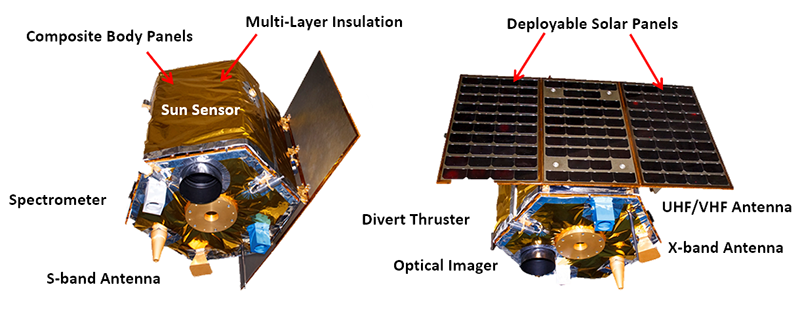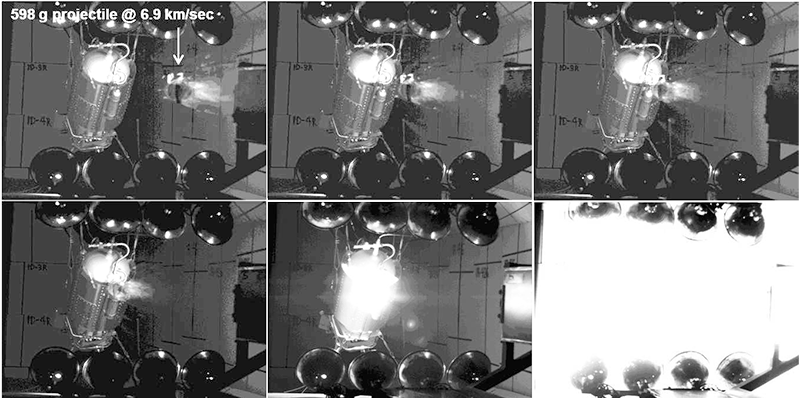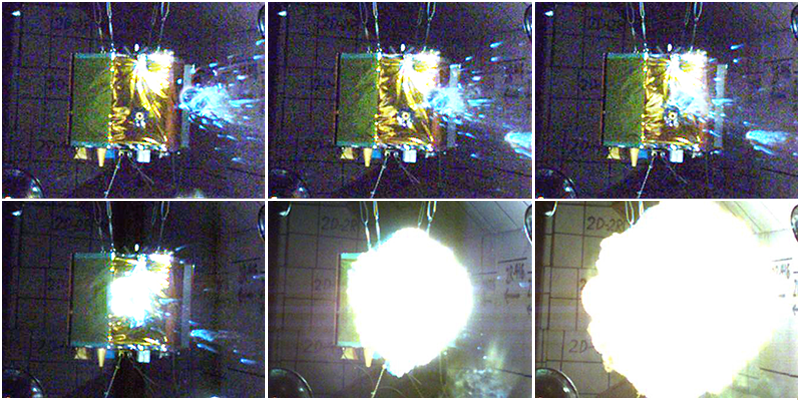DebriSat
The DebriSat project is a collaboration of the NASA Orbital Debris Program Office (ODPO), the Space Force Space Systems Command (SSC), The Aerospace Corporation (Aerospace), the University of Florida, and the
Air Force Arnold Engineering Development Complex (AEDC). The project's goal is to design and fabricate a 56-kg
class spacecraft mock-up (“DebriSat”) representative of modern payloads in the low Earth orbit (LEO) environment,
conduct a hypervelocity impact test to catastrophically break it up, collect fragments as small as 2 millimeters
in size, measure and characterize the fragment properties, and then use the data to improve space situational
awareness and satellite breakup models.
Also at AEDC in 1992, a key impact test series, Satellite Orbital debris Characterization Impact Test (SOCIT),
was conducted by the Department of Defense and NASA to support the development of satellite breakup models.
The main target for SOCIT was a fully functional U.S. Navy Transit satellite. The DoD and NASA breakup models
based on the SOCIT data have supported many applications and matched on-orbit events reasonably well over the years.
As new materials and construction techniques are developed for modern satellites, however, there is a
need for new laboratory-based tests to acquire data to improve the existing DOD and NASA breakup models. The
need for such tests is also supported by discrepancies between model predictions and observations of fragments
generated from the breakup of modern satellites
(e.g., Orbital Debris Quarterly News, July 2009, pp. 5-6).
The DebriSat design was based on a survey of modern satellites in LEO
[Clark,
Werremeyer].
All major design decisions, including the selection of components, subsystems, mass fractions, structure, and
construction methods were reviewed and approved by Aerospace subject matter experts. Shown in Figure 1,
the DebriSat body was covered with multi-layer insulation (MLI) and three solar panels were attached to one
side of the main body. The table, displayed in Figure 2, shows a comparison of DebriSat and SOCIT
targets and test conditions.

Figure 1: Picture of the DebriSat Satellite. Credit: University of Florida.
| Figure 2: Comparison | SOCIT/Transit | DebriSat | DebrisLV |
|---|---|---|---|
| Target body dimensions | 46 cm (dia) × 30 cm (ht) | 60 cm (dia) × 50 cm (ht) | 35 cm (dia ) × 88 cm (ht) |
| Target mass | 34.5 kg | 56 kg | 17.1 kg |
| MLI and solar panel | No | Yes | No |
| Projectile material | Al sphere | Hollow Al cylinder with attached nylon bore-rider | Hollow Al cylinder with attached nylon bore-rider |
| Projectile dimension/mass | 4.7 cm diameter, 150 g | 8.6 cm × 9 cm, 570 g | 8.6 cm × 9 cm, 598 g |
| Impact speed | 6.1 km/sec | 6.8 km/sec | 6.9 km/sec |
| Impact Energy to Target Mass ratio (EMR) |
81 J/g (2.8 MJ total) | 235 J/g (13.2 MJ total) | 832 J/g (14.2 MJ total) |
| Soft-Catch System: Polyurethane foam stacks | 3 densities: 0.06, 0.096, and 0.192 g/cm3; 25 cm thick | 3 densities: 0.048, 0.096, and 0.192 g/cm3; up to 61 cm thick | 3 densities: 0.048, 0.096, and 0.192 g/cm3; up to 51 cm thick |
To reduce the project cost, a decision was made to emulate the majority of components. The emulated components were
based on existing designs of flight hardware, including structure, dimensions, materials, and connection mechanisms.
At the end of the assembly, DebriSat was subjected to a standard vibration test to ensure the integrity of the structure.
To increase the project’s benefits further, Aerospace designed and built a target resembling a launch vehicle upper
stage (“DebrisLV”) for the pre-test shot. DebrisLV had a mass of 17.1 kg with body dimensions of 35 cm (diameter)
× 88 cm (length).
Hypervelocity Impact Tests
A key element for the DebriSat impact test was the design and installation of a soft-catch system inside the
target chamber that would slow down and capture fragments after the projectile impact, similar to the original
SOCIT test series. Several polyurethane foam stacks, consisting of panels with different densities (0.06, 0.096,
and 0.192 g/cm3) and with a total thickness of up to 25 cm, were used in the downrange and sideways
directions during the SOCIT test series.
For DebriSat, the same foam material with three different densities (0.048, 0.096, and 0.192 g/cm3)
was used but with an increased thickness of up to 61 cm. In addition, the interior of the target chamber was fully
covered with the soft-catch foam panels to prevent any fragments from impacting the chamber walls, which would
produce secondary damage (to the flying debris fragments) not associated with the breakup.
Slow-motion video of projectile striking DebriSat. Credit: Arnold Engineering Development Complex/Air Force.
The hypervelocity impacts of DebrisLV and DebriSat were conducted at the Range G facility at AEDC. Range G
operates the largest two-stage light gas gun in the United States. To maximize the projectile mass at the 7 km/sec
impact speed, the AEDC team developed a special projectile design featuring a hollow aluminum cylinder embedded in
a nylon cap. The nylon cap served as a bore rider for the aluminum cylinder to prevent hydrogen leakage and also
to protect the barrel. Using the bore rider eliminated the need for a sabot, which holds a projectile during
acceleration but is discarded after it leaves the gun barrel. This removes energy that could have been carried
by the projectile, and introduces the possibility of uncharacterized secondary impacts by sabot fragments.
The DebrisLV and DebriSat impacts were successfully carried out at AEDC Range G on 1 April and 15 April 2014,
respectively. Figures 3 and Figure 4 show the impact sequences of DebrisLV and DebriSat, in that
order. Portions of the rear nylon cap fragmented and trailed the aluminum cylinder during flight, but this did
not affect the planned catastrophic outcome of the impact.
Figure 3
Impact sequences of DebrisLV. Credit: Arnold Engineering Development Complex/Air Force.
Impact sequences of DebrisLV. Credit: Arnold Engineering Development Complex/Air Force.

Figure 4
Impact sequences of DebrisSat. Credit: Arnold Engineering Development Complex/Air Force.
Impact sequences of DebrisSat. Credit: Arnold Engineering Development Complex/Air Force.

Fragment Collection, Processing, and Future Measurement Plan
After the impact of DebrisLV, all intact foam panels, broken foam pieces, loose fragments, and dust were carefully
collected, documented, and placed in bags or plastic containers for shipping to a storage facility. The same process
was repeated after the DebriSat impact. Simple, ballpark estimates based on the current NASA Breakup Model indicate
the number of 2 mm (and larger) fragments from DebriSat and DebrisLV are approximately 85,000 and 35,000, respectively.
The effort to process the foam panels and to extract fragments is a very time consuming task. X-ray scanning of the foam
panels and broken foam pieces is underway. This will help identify the locations of embedded fragments with sizes of 2
mm and larger, speeding the extraction of those fragments. Once the fragments are available for measurements, each piece’s
three orthogonal dimensions and mass will be measured and recorded in a database, along with a description of its material
constituents and shape classification. The data will be processed and analyzed to improve the satellite breakup model for
collisions.
Representative fragments also will be selected for 3-D scanning measurements to obtain cross-sectional area and volume
data, yielding area-to-mass ratio, volume, and density distributions. Additional representative fragments will be selected
and subjected to laboratory radar and optical measurements to improve the radar debris size estimation model, to develop an
optical debris size estimation model, and to bridge the interpretation of ground-based radar and optical observations of
debris populations in Earth orbit.